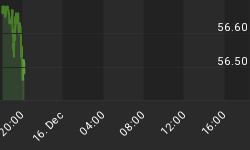One thing this market doesn't need is too much bullishness. The lack of bears means that there is little short covering fuel to power a move higher, and with too many bulls, there is less firepower on the sidelines to prop up a failing rally. It is true that it does take bulls to make a bull market, but those bulls usually have something to celebrate like a strong economy or a stimulus package, such as QE2. The Fed has told us this past week that "there are significant downside risks to the economic outlook, including strains in global financial markets." So in this sense, the market is all about Europe. If Europe can put together a bail out package, one would have to guess that this would be the event that would keep the party going.
The "Dumb Money" indicator (see figure 1) looks for extremes in the data from 4 different groups of investors who historically have been wrong on the market: 1) Investors Intelligence; 2) MarketVane; 3) American Association of Individual Investors; and 4) the put call ratio. This indicator shows neutral sentiment.
Figure 1. "Dumb Money"/ weekly
Figure 2 is a weekly chart of the SP500 with the InsiderScore "entire market" value in the lower panel. From the InsiderScore weekly report: "Insider sentiment, as measured by our Industry Score, has moved to its most bearish level since the week ended May 17, 2011, which as two weeks after the market hit a three-year high, as transactional volume has increased in the wake of the first big tranche of earnings announcements. Last week, sellers outnumbered buyers by a more than 3-to-1 margin and the number of sellers jumped 140% week-over-week compared to just an 18% increase in the number of buyers. Selling as concentrated in the Consumer Discretionary and Technology sectors, with less demonstrative contributions coming from the Consumer Staples and Industrial Goods groups....This is an inauspicious start to the most intense period of insider activity of the quarter."
Figure 2. InsiderScore "Entire Market" value/ weekly
Figure 3 is a weekly chart of the SP500. The indicator in the lower panel measures all the assets in the Rydex bullish oriented equity funds divided by the sum of assets in the bullish oriented equity funds plus the assets in the bearish oriented equity funds. When the indicatoris green, the value is low and there is fear in the market; this is where market bottoms are forged. When the indicator is red, there is complacency in the market. There are too many bulls and this is when market advances stall. Currently, the value of the indicator is 61.13%. Values less than 50% are associated with market bottoms. Values greater than 58% are associated with market tops.
Figure 3. Rydex Total Bull v. Total Bear/ weekly
Let me also remind readers that we are offering a 1 month FREE TRIAL to our Daily Sentiment Report (formerly Premium Content), which focuses on daily market sentiment and the Rydex asset data. This is excellent data based upon real assets not opinions! We have a new 1-click sign up process! Credit cards are not required.
















